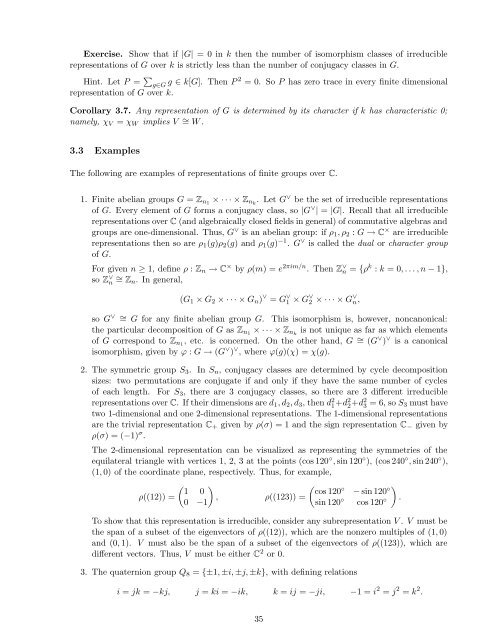Lecture notes for Introduction to Representation Theory
Lecture notes for Introduction to Representation Theory
Lecture notes for Introduction to Representation Theory
You also want an ePaper? Increase the reach of your titles
YUMPU automatically turns print PDFs into web optimized ePapers that Google loves.
Exercise. Show that if | G | = 0 in k then the number of isomorphism classes of irreducible<br />
representations of G over k is strictly less than the number of conjugacy classes in G.<br />
Hint. Let P = ⎨ gG g k[G]. Then P 2 = 0. So P has zero trace in every finite dimensional<br />
representation of G over k.<br />
Corollary 3.7. Any representation of G is determined by its character if k has characteristic 0;<br />
namely, ν V = ν W implies V ∪ = W .<br />
3.3 Examples<br />
The following are examples of representations of finite groups over C.<br />
1. Finite abelian groups G = Z n1 × · · · × Z nk . Let G ∗ be the set of irreducible representations<br />
of G. Every element of G <strong>for</strong>ms a conjugacy class, so | G ∗ | = | G | . Recall that all irreducible<br />
representations over C (and algebraically closed fields in general) of commutative algebras and<br />
groups are one-dimensional. Thus, G ∗ is an abelian group: if δ 1 , δ 2 : G ⊃ C × are irreducible<br />
representations then so are δ 1 (g)δ 2 (g) and δ 1 (g) −1 . G ∗ is called the dual or character group<br />
of G.<br />
For given n ⊂ 1, define δ : Z n ⊃ C × by δ(m) = e 2νim/n . Then Z ∗ n = {δ k : k = 0, . . . , n − 1},<br />
so Z ∗ = ∪ n Z n . In general,<br />
(G 1 × G 2 × · · · × G n ) ∗ = G ∗ 1 × G ∗ 2 × · · · × G ∗ n ,<br />
so G ∗ = ∪ G <strong>for</strong> any finite abelian group G. This isomorphism is, however, noncanonical:<br />
the particular decomposition of G as Z n1 × · · · × Z nk is not unique as far as which elements<br />
of G correspond <strong>to</strong> Z n1 , etc. is concerned. On the other hand, G ∪ = (G ∗ ) ∗ is a canonical<br />
isomorphism, given by : G ⊃ (G ∗ ) ∗ , where (g)(ν) = ν(g).<br />
2. The symmetric group S 3 . In S n , conjugacy classes are determined by cycle decomposition<br />
sizes: two permutations are conjugate if and only if they have the same number of cycles<br />
of each length. For S 3 , there are 3 conjugacy classes, so there are 3 different irreducible<br />
representations over C. If their dimensions are d 1 , d 2 , d 3 , then d2 1 +d 2 2 +d 3 2 = 6, so S 3 must have<br />
two 1-dimensional and one 2-dimensional representations. The 1-dimensional representations<br />
are the trivial representation C + given by δ(ε) = 1 and the sign representation C given by<br />
δ(ε) = (−1) ε −<br />
.<br />
The 2-dimensional representation can be visualized as representing the symmetries of the<br />
equilateral triangle with vertices 1, 2, 3 at the points (cos 120 ∨ , sin 120 ∨ ), (cos 240 ∨ , sin 240 ∨ ),<br />
(1, 0) of the coordinate plane, respectively. Thus, <strong>for</strong> example,<br />
1 0<br />
cos 120<br />
∨<br />
− sin 120 ∨<br />
δ((12)) = , δ((123)) = .<br />
0 −1 sin 120 ∨ cos 120 ∨<br />
To show that this representation is irreducible, consider any subrepresentation V . V must be<br />
the span of a subset of the eigenvec<strong>to</strong>rs of δ((12)), which are the nonzero multiples of (1, 0)<br />
and (0, 1). V must also be the span of a subset of the eigenvec<strong>to</strong>rs of δ((123)), which are<br />
different vec<strong>to</strong>rs. Thus, V must be either C 2 or 0.<br />
3. The quaternion group Q 8 = {±1, ±i, ±j, ±k}, with defining relations<br />
i = jk = −kj, j = ki = −ik, k = ij = −ji, −1 = i 2 = j 2 = k 2 .<br />
35

















